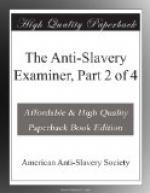She seldom manifested her evil temper before master George. When she did, he was greatly troubled, and he used to speak to his sisters about it. Her manner towards him was almost invariably that of extreme fondness. She was dark complexioned, but very beautiful; and the smile of welcome with which she used to meet him was peculiarly fascinating. I did not marvel that he loved her; while at the same time, in common with all the house servants, I regarded her as a being possessed with an evil spirit,—half woman, and half fiend.
Soon after the settlement of the estate, I heard my master speak of going out to Alabama. His wife had 1500 acres of wild land in Greene County in that State: and he had been negociating for 500 more. Early in the summer of 1833, he commenced making preparations for removing to that place a sufficient number of hands to cultivate it. He took great pains to buy up the wives and husbands of those of his own slaves who had married out of the estate, in order, as he said, that his hands might be contented in Alabama, and not need chaining together while on their journey. It is always found necessary by the regular slave-traders, in travelling with their slaves to the far South, to handcuff and chain their wretched victims, who have been bought up as the interest of the trader, and the luxury or necessities of the planter may chance to require, without regard to the ties sundered or the affections made desolate, by these infernal bargains. About the 1st of September, after the slaves destined for Alabama had taken a final farewell of their old home, and of the friends they were leaving behind, our party started on their long journey. There were in all 214 slaves, men, women and children. The men and women travelled on foot—the small children in the wagons, containing the baggage, &c. Previous to my departure, I visited my wife and children at Mr. Gatewood’s. I took leave of them with the belief that I should return with my master, as soon as he had seen his hands established on his new plantation. I took my children in my arms and embraced them; my wife, who was a member of the Methodist church, implored the blessing of God upon me, during my absence, and I turned away to follow my master.




